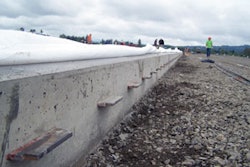PHOENIX - HercuWall a new patented, "green", concrete wall-building system is partnering with an assemblage of Phoenix area contractors and suppliers to demonstrate "green" building technologies in the first concrete Habitat for Humanity® home in Arizona.
The project is spearheaded by the award-winning Salt River Materials Group (SRMG) of Scottsdale, and will be introduced here at the Greenbuild International Conference & Expo, November 10-12. Among 200 entries, the Habitat home was selected for the Contemporary Living Desert Tour which is also available to the public November 14; tickets are available at www.usgbc.org.
The Habitat for Humanity home features HercuWall instead of conventional wood-frame construction. By combining HercuWall with conditioned attic space using spray foam in the roof deck, and energy-efficient windows and HVAC equipment, this home has the essential elements to reach the coveted "Net Zero" energy designation. Exceeding Energy Star certification, the project's additional "green" products contributed to an overall LEED for Homes "Platinum" designation, meeting the highest U.S. standards. Eighty out of 126 points are required for Platinum certification and the Habitat home scored a massive 114.5.
The HERS Index Score for energy rating was finalized at -4 (negative four). That is better than zero-energy and depending on the family's usage, they could actually put energy back out on the grid. Even without the solar component, the HERS Index is 54. For reference, the current Energy Star program is HERS 85. This means that the Habitat home's design without photovoltaics (solar) is 46% more efficient than the 2006 Model Energy Code being used today. These findings are good news for production homebuilders seeking cost-efficient means to include energy-saving and green innovations.
Scott Palmer, an executive with SRMG who also serves on the Portland Cement Association's board of directors as Chair of Residential Construction, said the new home is a first of its kind. "This home gives the opportunity to showcase cement-based products in 'green building' applications to production homebuilders, and to Habitat for Humanity International at the corporate level," said Palmer. "Innovative 'green' concrete wall building systems, which could transform homebuilding across the globe, install quickly and are affordable even for entry-level housing."
Michael Niemann, CEO of HercuWall Inc., said the new product is constructed with EPS foam and reinforced concrete, and benefits homeowners by providing a stronger, quieter, mold and termite free environment. He said partnering with Icynene attic insulation and Pella windows and doors contributes to an energy-efficient, thermal building envelope that reduces the cost of utilities by 40% to 60%. HercuWall also benefits the environment by saving trees, reducing emissions and lowering overall energy usage year after year. With this system for building exterior walls, contractors now can offer true green construction for residential and commercial applications providing better quality at a competitive price.
Habitat for Humanity projects are built with some contracted but mostly volunteer labor and is based on a partnership between a family and the community. Local community involvement includes SRMG's financial corporate sponsorship, in-kind donations from companies like HercuWall, Pella, Eagle Roofing, Icynene, and many others, plus a significant volunteer workforce. Volunteers work alongside the family to provide labor during most phases of the home's construction. Habitat is committed to resource- and energy-efficient building practices that conserve natural resources and reduce long-term costs for Habitat homeowners.
Described as the "Net Zero Energy-Concrete Habitat for Humanity Home of the Future," other cement-based products such as a pervious concrete driveway, concrete countertops, and integral color concrete floors display the versatility and desirability of using these materials. One of the measurable energy savings is that instead of a code-prescribed 4-ton HVAC unit, the Habitat home required only 1.5 ton.
Arriving as a pre-engineered "kit", a four-man crew offloaded and set the HercuWall perimeter walls for Habitat's 1,320 sq. ft home in roughly 2.5 hours and poured the concrete in less than two hours. No site modification of the system was required, eliminating jobsite clutter affiliated with traditional systems. Window and door opening "blanks" are recycled by the foam supplier.
Termed Beyond ICF technology, the HercuWall panels are manufactured to match the plate height of the wall and can be manufactured up to 12 ft. tall. Requiring minimal bracing, the poured panels remain in place with the foam and concrete acting as R30 insulation. Taller walls can be built by stacking the panels on top of each other. True curved wall sections like turrets, for example, can be manufactured at any radius required by the architect.
Integral hardware ensures that rebar is placed securely and positioned correctly every time with minimal effort. There is no guessing; eliminating problems. Full height metal furring strips, which are spaced on 24-in. centers on each side of the panels, serve as fastening points for interior drywall and ready for exterior surfaces with a choice of stucco, brick, stone, or siding finishes.
Features of a LEED certified home include: improved indoor air quality, durability of construction, minimized environmental footprint, increased water efficiency, and improved energy efficiency. This home also achieved a Certified Environments For Living Home-Certified Green and EFL Platinum Certified.
By demonstrating the affordability of using energy-efficient, green technologies like HercuWall in entry-level housing, this translates to cost savings for custom and production builders. With the ability to build faster, stronger, and smarter, contractors can differentiate themselves as the consumer's preferred green alternative. Palmer shares, "Not only have we developed a high-performance home that will exceed the stringent regulations set forth in the current Energy Bill for new home construction, but more importantly, we have provided a very high quality and beautiful home for a deserving family."


















